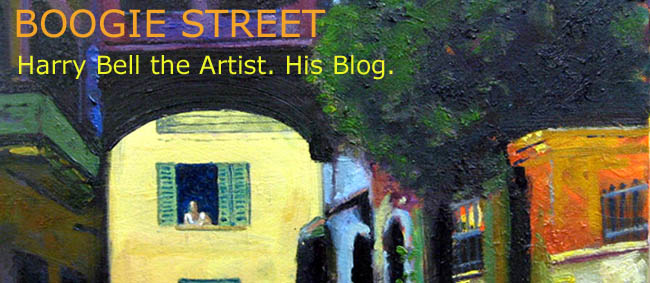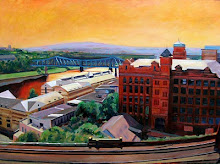Over the past few years I've been approached by GCSE A level students asking to use me as the subject for their Art Project. There must have been about 6 or 7 of them so far. At first they asked for a face-to-face interview and I gave in to that. But when my request for a copy of what they eventually wrote was always promised but never supplied, I switched to offering to answer questions put to me by email. At least that way I have a record of what I said, which can be useful to me in considering my work
I answered the most recent questionnaire in December and I thought it might be of interest if I posted an edited version of it here:
1. What was your earliest realisation that you wanted to become an artist?
Although I’ve always spent a lot of time drawing, it wasn’t until I was in my early twenties that I began to think of it seriously. Even then I don’t think I realised it might be possible for me to be a professional artist. It wasn’t until I became involved with people in the publishing industry throughout the 1970s and 1980s that I began to consider and look for ways of becoming an illustrator. This led to a greater involvement with painting and by about 1985 I knew that I needed to paint full time. It took a long time to come to this conclusion, but sometimes it does seem that what you really want to do dawns on you only slowly.
2. Which artists do you admire and why?In no particular order:
David Bomberg – beautiful drawings and paintings of London and Spain.
Walter Sickert – solidly structured paintings of great tonal strength.
Graham Sutherland - I wrote my Dissertation on his Pembrokeshire landscapes.
Paul Nash –landscapes with a very English Surrealist slant.
Carel Weight – his pictures are very English, with quirky happenings.
John Piper – his mixed media evocations of the British landscape are so Romantic.
Bill Jacklin – another excellent contemporary painter of the urban scene.
Balthus – a painter of strange, unsettling pictures.
Edward Hopper – the quintessential 20thC painter of townscapes.
Richard Diebenkorn – his still lifes and suburban landscapes are masterpieces.
Wolf Kahn – for his daring use of colours which quite simply shouldn’t work together, but do.
Wayne Thiebaud – for his West Coast townscapes, landscapes and paintings of pies, ice cream cones and gumball machines. A great realist painter.
3. What were the most significant influences on your style?A love of the contrast of light and dark and a somewhat melancholic disposition which sometimes produces pictures imbued with a lonely or even eerie atmosphere.
4. What are the most significant influences on your choice of subject matter?
I was born in Gateshead, where I still live, and growing up there I was surrounded by Tyneside’s urban sprawl. When it came to finding suitable subject matter for paintings, it was inevitable, I suppose, that urban subjects should be what I turned to.
5. What inspires you?
It’s always something seen. Something catches my eye and I know that it has the potential to make a painting. Usually, what I notice first is an arrangement of shapes produced by strong sunlight and the resultant shadows on a group of buildings.
6. How has your work developed and changed throughout your career? What influences caused this?
The first influence on my work was Andrew Gifford. He was studying for his BA at Newcastle when I was attending OCA tutorials there. I used to see Gifford’s work in the studios and I began to find a language in his views of the Tyne that I could use in my own paintings. At the same time, the OCA tutor encouraged me to adopt a broad approach to my picture-making on the principle that “it’s better to suggest than to describe.” Following these two sources, I developed a series of rather sombre paintings of the Tyne gorge.
Eventually my reading brought me to more colourful painters, like the Americans Richard Diebenkorn and Wayne Thiebaud. Diebenkorn’s mid-career figurative work was colourful and loosely painted as befits his beginnings as a Bay Area Abstract Expressionist and Wayne Thiebaud’s paintings of the vertiginous streets of San Francisco showed what could be done with the city as subject.
At University I was encouraged to use soft brushes and to eliminate the more obvious effects of a personal handwriting, which produced work in more of a tightly-delineated realist vein. It took me several years after graduation to realise that wasn’t what I wanted and I’m only now divesting myself of much of that approach.
In the last couple of years I’ve been looking at the work of Wolf Kahn, another American painter whose own fascination is with the interaction of pure colour applied to the landscape. Together with increased travelling in the Mediterranean area, this has led me into investigations of much more colour-dominated work.
Running throughout all of this time, of course, has been an interest in the work of Edward Hopper. Hopper remains for me the quintessential urban painter.
7. What ambitions do you have for the future?Only to go on painting and, as often as possible, getting the pictures on walls where people can see them. I don’t believe the creative process is finished until the pictures have been exhibited.
8. How do you see your work developing in the future?Difficult to say. My most recent work has seen an increased interest in the use of colour, but I think I’m stepping back a little from that now. As a naturally tonal painter, I find I’m uncomfortable with the inevitable loss of tonal form that the real colourist has to embrace. But my interest in the formal structure of the painting continues. My most recent work displays greater emphasis on the picture plane, with flattened perspective, banding and more gestural mark making. Inevitably, however, the making of pictures suggests ways of development, so that, however much you may intellectualise about the direction you want to take, the work will lead you in unforeseen directions.
9. Which work/s do you consider to be your most successful and/or significant to date? The most recent one is always the most interesting, but it’s difficult to look at any of them and regard them as successful. Some are more successful than others, but almost all are flawed. At any one time, however, I could single out a different painting and find new inspiration in it. Art comes from art.


.jpg)
.jpg)
.jpg)
.jpg)













